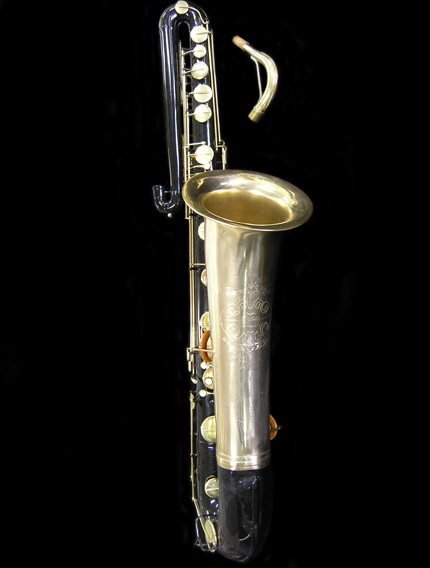 I happened to be perusing through eBay ads last pm looking at saxophones, and I came across this rather unusual bass saxophone offered for auction by Saxquest. Saxquest describes the horn as:
I happened to be perusing through eBay ads last pm looking at saxophones, and I came across this rather unusual bass saxophone offered for auction by Saxquest. Saxquest describes the horn as:
“Here’s a unique find – this is an old vintage Holton bass saxophone, serial number 13734, that has been completely restored in a different look. This body of this horn has been black lacquered, with the bell and keywork stripped and given a clear coat of lacquer, giving the instrument as a whole a very cool look.
Physically the sax is in great shape despite its age. It has a few minor dings, one small dent near the bottom of the bell, but nothing major and definitely nothing that affects the way the horn plays. It has all new pads, with large metal domed resonators, and is sealing great. We recently went through the instrument to make sure it was playing fine and it is in awesome shape mechanically.
For a sax player there is definitely something satisfying about playing a good powerful bass. This instrument has a great response in the lower register and really plays with authority. Solid tone up and down the range of the instrument. This is a great sax that should go for a good price. It does ship in a custom-made wood shell case.”
Now there are some very strange and mysterious things about this horn, and thus it instantly peaked my curiosity, since it combined by love of vintage and bass saxophones, with my love of mysteries.
One of the first things that is obvious, is that the neck looks strange. It is not the shape of a typical bass saxophone neck.
Source: eBay.com
Not only is the shape different than a regular bass neck, but the fact that it has a brace, is different as well. The whole neck looks aftermarket. But the question is: Who made it?
The horn itself is no less of a mystery than the neck. Saxquest says that the horn has been “black lacquered”. Now I admit that I’m not an expert on the lacquering process, but I’ve been playing for more than 25 years, and have literally seen thousands of horns in person. I have never seen a lacquer job that looks like this…
Source: eBay.com
This orange peel texture really looks more like an enamel paint finish than a lacquer job. The finish also appears too thick to be lacquer. Further evidence of this is is apparent when you look at the other photos.
Then another question that begs an answer is: Who made it? The horn does not have the French wrap, but rather the American design, so Conn or Buescher are the most likely suspects.
Source: eBay.com
The left hand pinky cluster shows a pearl G# key which could be either Buescher or Conn.
Source: eBay.com
The octave key lever doesn’t look like a Buescher’s. BTW, note the black “lacquer” on the thumb rest.
Source: eBay.com
The Mercedes-style low C style keyguard is classic Conn.
Source: eBay.com
I don’t know if this spit valve is original, but I strongly suspect that it was added later. It looks identical to the one that was added by Paul Woltz to Jim Glass’s 1921 Buescher bass.
Source: eBay.com
The left hand palm keys are a rather odd design. I am curious how comfortable they would be.
Source: eBay.com
The engraving on the horn is still crisp.
Source: eBay.com
All in all, it’s a very pretty horn.
Source: eBay.com
Because my curiosity was peaked, I figured it would have attracted the attention of others as well. I checked out all the usual places where bass sax players might have mentioned the horn, and I found a thread on SOTW. The players there were as conflicted as I was. Although one player who replied does have a Holton bass that is a Conn stencil, and says his horn has the same keywork as this one does.
I remember a couple of years ago Gayle at Vintage Sax.com had a bass that had the same kind of finish: black body and lacquer keys & bell. It too was a stencil horn, but I’m not 100% sure it was a Holton. I’m wondering if this isn’t the same horn though. It seems rather coincidental that 2 bass saxophones, both stencil horns, end up refinished black and gold.
Anyways, this is an interesting saxophone. There are lots of questions about its pedigree, and aftermarket “whats its”. But whoever ends up buying it will certainly stand out in the crowd though, even more so than he or she would if they were playing just a regular, everyday vintage bass.


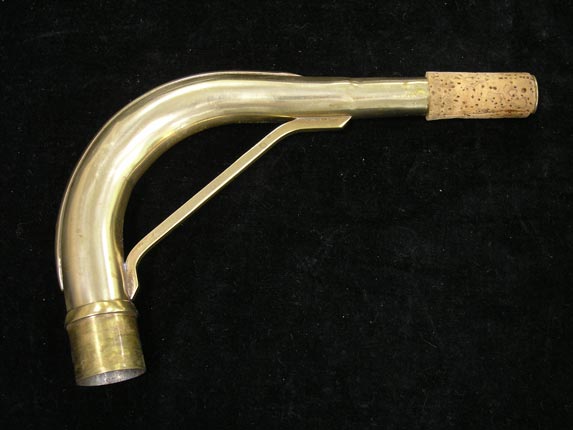
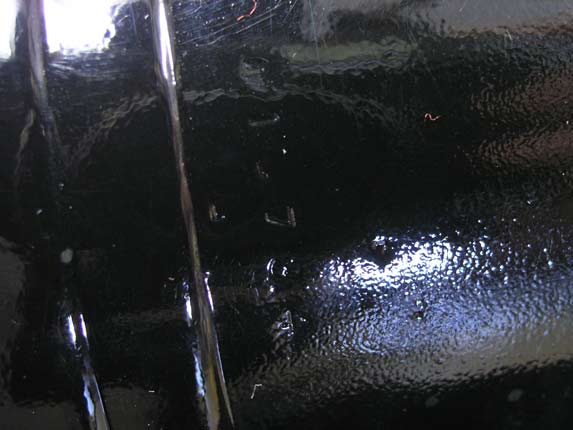
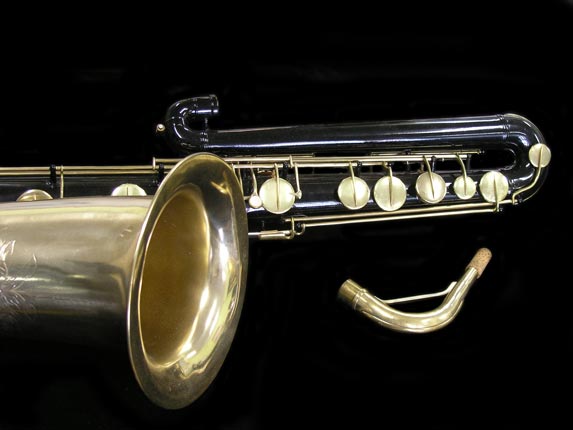
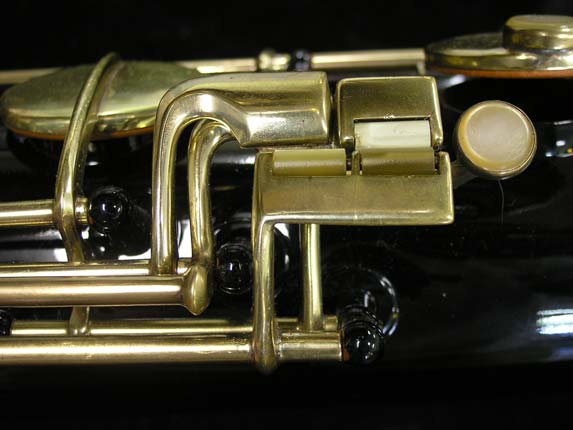

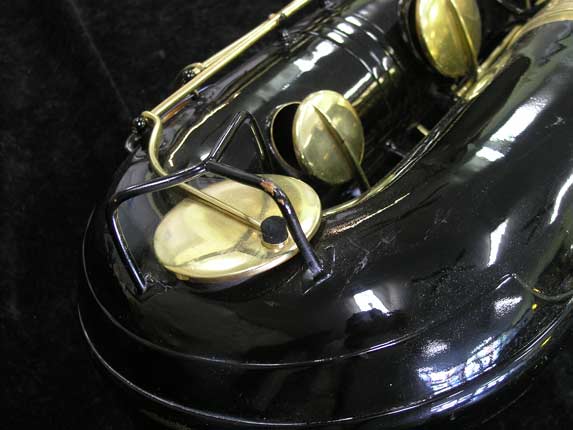
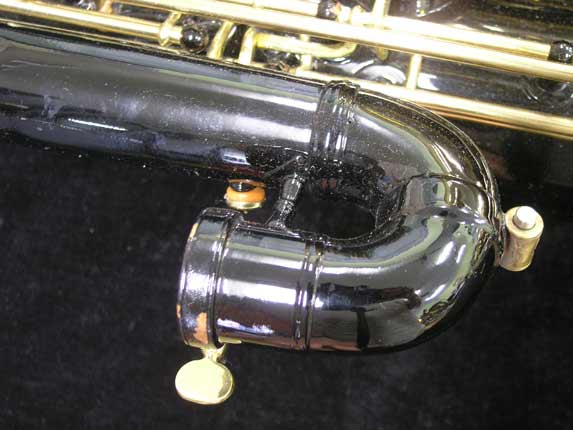
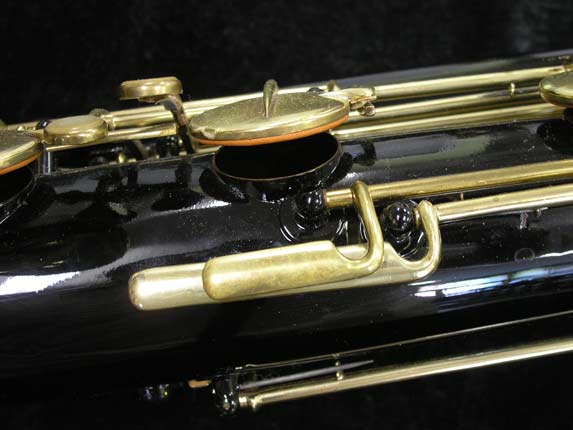

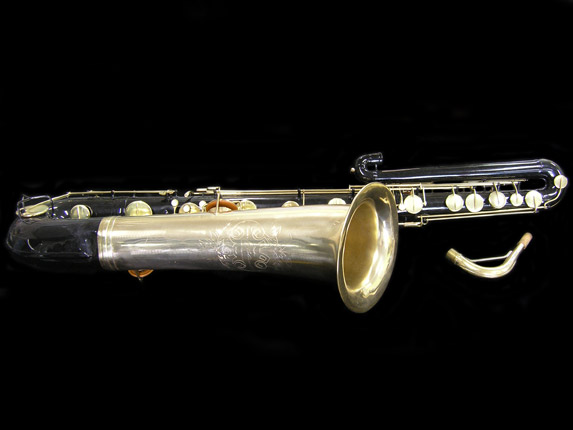

IIRC, certain original bass reeds may have been a bit wider, but as a general rule, yes, the two types are very close. That’s why so many of us use bari reeds on bass sax.
Even my bass sax m/p, a vintage Geo Bundy piece, is the perfect width for a baritone reed.
I use my soft Fibracell reeds on both my custom bass mouthpieces (made from bari blanks)as well as my original bass mouthpiece. It’s very handy not having to buy different reeds for different mouthpieces.
I’ve been using bass sax reeds (Rico’s bass sax/contra alto/ contrabass clarinet reeds). It’s interesting how close in size the bass and baritone reeds are. I notice the basses are only about a millimeter wider than the baritones.
While in my experience Ricos are much softer than Vandorens, a 3 1/2 Rico is still a really hard reed for a bass sax. FWIW, I play 1.5 Fibracell reeds (or Soft with the older grading system) on my bass, yet play Medium Soft on the rest of my horns (S,A,T,& B).
If you find that you’re still fighting intonation, you might try to dial back on the strength of the reeds a notch or two. You may find that the intonation will come even closer into line. I’d try a 3 or a 2 1/2.
I meant to ask you, are you using bass sax reeds? Or something else? If so, what?
Have you tried a softer reed at all? I’m not familiar with the Selmer bass mouthpieces, so I don’t know their dimensions–specifically their width–but I’m wondering if a softer reed might help with some of the intonation issues you’re currently encountering. Most bass players do play softer reeds on bass then they do on the rest of the saxes they play. I’m just not sure what brand of reeds would be the right width for the m/p.
I know a number of players swear by the bass saxophone Légère reeds, available only through the company themselves at last report. Perhaps you prefer cane. However, the Légère bass sax reed has won over a number of bass players who used to only play on cane. I don’t know however how the width of the reed would be on the Selmer m/p. I’m sure the company could tell you however.
Maybe you’ve already experimented with reeds, in which case this is all not that useful to you. What have you tried?
What a difference softer reeds make! When I first bought the horn I was reluctant to use the 3 1/2 rico reeds that I bought because I didn’t think they sounded rich enough. But wow, the intonation is much much closer with ricos rather than vandorens.
I use a Selmer C* Bass Sax MPC and either a 2 and 1/2 or 3 vandoren paris reed
What kind of mouthpiece and reed setup are you using?
Intonation problems are just part of a vintage bass saxophone’s charm. 😉 I assume you’ve figured out the workarounds by now. Which notes are giving you troubles?
Yours is definitely a Conn stencil, the Mercedes style key guards give it away. I couldn’t figure out the neck though. Is it a regular neck? Or is it a sink trap like on the Martin stencil that just sold on eBay a couple of days ago?
Basically the whole upper register is sharp but I’m getting to be pretty accurate with it now and from low D to low B (except for C#) is flat. D is the most flat out of all the low notes. The neck is a regular neck.
I bought my horn April of last year. It plays great. There’s a couple of intonation problems that I’ve come close to eliminating. Here’s the link: http://www.usahorn.com/archive/Holton/698/Frank-Holton-Co-Bass-Saxophone-Lacquer-87XX.html
Hi Matt. Welcome to my website!
This particular bass was a bit of a puzzler. Someone obviously refinished it. It however appears to be a Conn stencil horn though.
How about yours? Do you know who made it? Do you have any photos you’d like to share?
According to Dr. Jay Easton, Holton, while they did begin making a few bass saxophones in the late 1920s, really had most of their bass saxophones made by Conn. Very few Holton-made bass saxophones are known to exist.
Wow! I bought my Holton Bass for $7600! I love the dark tone it makes. Thanks for the link for the serial numbers. My bass is from 1921. While it isn’t the prettiest horn it the sound that counts!
Update: This horn sold for $3327.77 on Oct. 18, 2008. My prediction: We’ll see it again on some auction site soon, only this time the winning bidder will be paying more for it!
I totally agree with you on the sound aspect Jim. I wish Saxquest had put up some sound files like Quinntheeskimo does for his horns. That would give the would-be-buyer something to go on.
I am very curious what that neck does to the intonation. Given the finickiness of vintage basses, it could improve it! Who knows? A sound sample would be a valuable selling feature, especially on a bit of an “unknown” like this one.
Yup, looks like an Amati trumpet spit valve like mine. Even though I think this instrument looks very nice, for me it’s all about the sound.